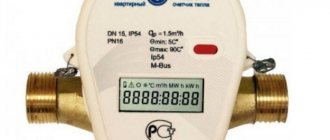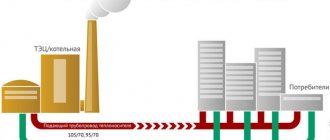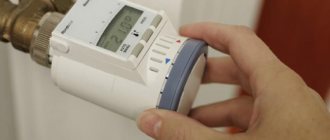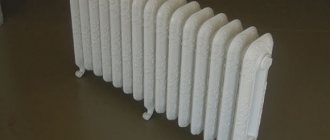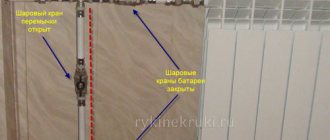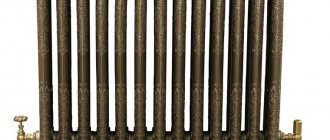How much does a communal heat meter cost?
The cost of installing a heating system for owners of premises in an apartment building consists of the following items:
- the cost of the meter itself and related materials;
- costs for the development of design documentation and documents containing the technical conditions of the heat supply system, without which the installation cannot be carried out;
- cost of installation work, including commissioning activities.
Prices for meters depend on the manufacturer and type of device:
- ultrasonic - the most expensive meter in the price range from 15 to 50 thousand rubles;
- electromagnetic costs 15-17 thousand rubles;
- a vortex will cost an average of 15 thousand rubles;
- tachometer is the most inexpensive option with a service life of no more than 4 years, its price is from 6 to 10 thousand rubles.
As a result, the total amount of all measures can range from 150 to 300 thousand rubles, which residents can repay at a time, in installments or using funds collected for major repairs.
Installation procedure for a collective heat meter
If the centralized heat supply system has the technical ability to install a common house heat meter, it must be installed.
In newly built houses, energy meters are installed before the facility is put into operation. This requirement is contained in the law on the installation of a common house meter dated November 23, 2009 No. 261-FZ in paragraphs 7-8 of Article 11, and paragraph 9 of Article 13 defines the area of responsibilities for installing a public meter in houses where it is not available.
In order for a common house meter to appear in your home, you must go through several stages of its installation procedure.
- A meeting of owners of an apartment building (MKD) is the basis for the installation of heat meters for heating in an apartment building.
- The meeting may be initiated by the Management Company. In HOAs, housing cooperatives, and residential complexes, the meeting is held on the basis of an application from the owners; 10% of the signatures of the total number of votes is sufficient.
- Technical conditions for the installation of an ODPU, in accordance with which its design and installation will be carried out, are issued by the heat supply organization.
- The installation project and the estimate for the work are prepared by the design organization, taking into account the specific installation location and indicating the device model.
- Coordination of the project with the heat supply organization that issued the technical specifications.
- Purchasing a project-approved ODPU, mandatory with a verification stamp.
- Installation of ODPU and putting the meter into operation.
Organizations responsible for installing ODPU
According to Law No. 261-FZ, the responsibility for installing a collective heat meter is assigned to the owners of apartments in a multi-storey building, who must carry out this activity independently, choosing an equipment supplier and a contractor for the work.
Assuming that there will be houses that are not equipped with ODPU, legislators determined who should install heat meters in this case. So, if on July 1, 2012, houses did not have a heat meter, the responsibility for installing it was transferred to the resource supply organization (RSO).
In addition, the RSO is obliged to prepare proposals for equipping apartment buildings with metering devices and carry out the corresponding work, which is confirmed in the letter of the Federal Antimonopoly Service of Russia dated December 8, 2011 No. AG/45584.
Thus, the widespread information that the management company installs heating meters is erroneous. The task of the management company is only to:
- bring to the attention of the owners of apartments in apartment buildings the need to install a collective heat meter;
- organize a meeting;
- draw up a protocol of consent.
Activities for installing the device can be carried out by heat energy supply organizations or specialized companies that have:
- Qualified specialists on staff of the company.
- Permission to perform the relevant type of work, issued by SRO.
How to avoid paying for the installation of a communal meter
Installing a meter can be free for residents if the management company or the HOA that manages the house enters into an agreement with an energy service company (ESC). Then the metering device will be installed at her expense and leased to the owners of the apartment building for a time.
In fact, such a mechanism involves covering the costs of the energy service company for installing the meter (with a planned profit) gradually, followed by transferring it to the ownership of the residents. The process is as follows:
- The management company or homeowners association enter into an agreement with the power supply company.
- ESC installs a common house heat meter from its own funds.
- Residents of the house pay for heat according to the meter and transfer 80% of the resulting savings to pay off the cost of its installation;
- After full reimbursement of ESC costs, the metering device is transferred to the residents' ownership.
For example, before the installation of ODPU heat, the owners of the building premises paid 620 thousand rubles. After installation, costs were reduced by 80 thousand rubles per month, which we will consider savings. Of this amount, 64 thousand rubles. (80% of the savings) residents will be able to contribute monthly to cover the costs associated with installing the meter.
The energy service company invested 284 thousand rubles in equipping the house with a metering device. rubles plus, under the terms of the contract, the expected profit will be 86 thousand rubles. Accordingly, after 6 months, a full calculation will be made and the meter will be transferred to the residents of the apartment building.
Who pays for the installation of communal metering devices?
In accordance with the Federal Law “On Energy Saving”, the cost of installing ODPU falls entirely on the owners of a residential building.
Owners of premises are required to pay the costs of installing a common house meter on the basis of invoices, except for cases where such costs were taken into account as part of the fee for the maintenance and repair of residential premises and (or) as part of mandatory payments and (or) contributions associated with the payment of expenses for maintenance, current and major repairs of common property.
RF PP dated August 13, 2006 No. 491, clause 38(1)
When installing common house metering devices, each owner is presented with an invoice for payment, which, in addition to general information about the cost of the metering device, contains information about how much a specific owner must pay.
The expenses of each owner are determined in the form of a share proportional to the share in the right of common ownership of the common property. To calculate this share, the total area of the premises is divided by the total area of the house and multiplied by the area of the common property.
For example, if the area of the premises is 100 m², the area of the house is 9,000 m², and the total property is 1,500 m², then the owner’s share will be: 100 / 9,000 x 1,500 = 16.67 m².
Is it necessary to hold a general meeting of owners?
From the “Rules for the maintenance of common property in an apartment building” it follows that shared property is common property. In particular, such meters are part of in-house engineering systems. Therefore, to install the ODPU, a decision of the general meeting of premises owners is required. The management company must inform the owners of the need to hold such a meeting.
Despite the fact that the role of the management company during the general meeting is limited only to introductory events, if the owners are not notified of the need to install metering devices, the management company faces a fine.
According to paragraph 5 of Article 9.16 of the Code of Administrative Offences, if the organizations responsible for the maintenance of apartment buildings avoid developing and communicating information about measures aimed at energy saving to homeowners, the controlling body in relation to the management company, the homeowners association will be sent an order to impose administrative liability in the form of a fine :
- for an official in the amount of 5,000 to 10,000 rubles;
- for a legal entity – from 20,000 to 30,000 rubles.
How do owners pay for the installation of communal metering devices?
Payment for installation of ODPU is made in one of the following ways:
- Make a one-time 100% deposit before or after installing the meter.
- Use the right to installments for 5 years. In this case, the owner’s share for paying for a common house meter is billed on the utility bill in equal installments over a period of 5 years. In this case, in addition to the cost of the device, an additional interest for installments is paid in the amount of the refinancing rate of the Central Bank of the Russian Federation.
- Use funds from the utility service provider allocated for energy saving and energy efficiency measures.
Funds allocated for energy saving measures
In accordance with Decree of the Government of the Russian Federation No. 354 of 05/06/2011 “On the provision of utility services to owners and users of premises in apartment buildings and residential buildings,” the provider of utility services must direct the resulting difference between the standard and the amount, taking into account the increasing factor, to energy saving measures.
Since the difference between the standard and the amount, taking into account the increasing factor, can only be used for energy saving measures, such funds have a targeted nature of spending, and according to accounting rules, it is necessary to ensure their separate accounting and storage from other income.
Let's look at an example. Let’s say the standard volume of water per person per month is 7 m³. The increasing coefficient in 2021 is 1.4. With a tariff of 14.63 rubles. for 1 m³, we get the following: 7 x 1.4 x 14.63 = 143.37 rubles.
In this case, the amount without standards would be as follows: 7 x 14.63 = 102.41 rubles.
Thus, the difference between the standard and the amount taking into account the increasing coefficient for water is: 143.37 - 102.41 = 39.96 rubles. It is this amount that should be allocated by the contractor for energy saving measures.
The installation of a common house metering device is considered an energy saving measure, therefore, if the owners of an apartment building decide to install a metering device and there are target savings in the account of the utility service provider, they must be used to pay for the installation of the metering device.
If owners refuse to pay for installation
If the owners refuse to pay for the installation of ODPU, such devices will be forcibly installed by the resource supply organization.
In accordance with clause 12 of Article 13 of the Federal Law “On Energy Saving”, owners are obliged to provide RSO employees with access to the installation sites of meters and pay the costs of installing metering devices. In case of refusal to reimburse the resource supplying organization for installation costs, the owners will additionally have to pay the costs associated with forced collection.
Why installation work is not carried out using current repair funds
Current repairs are timely planned preventive maintenance of utility systems, the main way to eliminate malfunctions and minor damage. The purpose of routine repairs is to protect property from premature wear and tear.
In accordance with the “Methodological manual for the maintenance and repair of housing stock” (MDK 2–04.2004), the cost of current repairs of a building should be at least 0.4 - 0.55% of its replacement cost. Inappropriate spending of current repair funds violates the schedule of planned preventative repairs, systematic failure of which can lead to an emergency, sudden failure of pumping equipment, collapse of utility facilities, as well as disruption of the functionality of building elements and energy metering units.
It is permissible to carry out work on the installation of ODPU at the expense of current repair funds if the property is in satisfactory condition. But, as a rule, the physical wear and tear of the housing stock is 70–80% and requires reconstruction.
Compliance with the schedule for scheduled maintenance is the main condition for the environmental and technical safety of residents living in the house. Therefore, in practice, payment for the installation of common house metering devices occurs either at the expense of the owners, or from separate targeted savings for energy saving at home.
Installation taking into account the legislative framework Federal Law-261
The main document on the installation and use of public meters is Federal Law No. 261-FZ of November 23, 2009 “On energy saving and increasing energy efficiency and on introducing amendments to certain legislative acts of the Russian Federation.”
According to the law, only organizations that supply energy resources and specialized equipment can install a meter. Such organizations must be members of an SRO in construction and have an SRO certificate of admission to this type of work.
Install a meter at the entrance of communications to the territory of the house. The invisible line separating the territory of the house management is called the boundary of operational responsibility. Possible heat losses at the location where the meter is installed are calculated and included in the heat supply contract. Like other metering devices, communal heat meters are sealed; you cannot simply change their settings.
Installing a meter requires professionalism, so choose contractors carefully: check their licenses and certificates, read reviews. Our company carries out all work related to heat energy accounting: we conduct energy audits, develop projects, select equipment and install it
Contact us for advice or installation of flow meters!
Subscribe to our newsletter and be one of the first to know all our news!
Common house heat meters
A common house heat meter will allow the user to reduce the amount of utility bills for heating a living space. However, in Russia they are in no hurry to equip apartment buildings with such meters. First of all, this is associated with high costs.
In 2009, the Government of the Russian Federation made a decision to equip apartment buildings with special heat metering devices. However, it came into force in 2012. But there are still no major advances from management companies to install such equipment.
The rule is regulated by Federal Law of the Russian Federation N261 “On energy saving and increasing energy efficiency and on introducing amendments to certain legislative acts of the Russian Federation” dated November 23, 2009. Please note that this legal act is planned to be amended in 2018, which will come into effect into force in 2021.
The federal law does not oblige all owners and management companies to equip apartment buildings with heat meters, but only recommends installing them. This is probably why management companies are reluctant to provide maintenance.
The decision to install a heat meter is made by the owners of an apartment building at a general meeting by voting. It is adopted if there is a majority of votes in favor.
Previously, thermal energy consumption was unmetered. The user fee is a fixed amount set in each region. Heat meters will help you save on utility bills.
The calculation of the amount of utility bills depends on the tariff adopted in the region and the total area of the living space. For example, if the owner owns an apartment with an area of 42 m2, and the regional tariff is 50 rubles, then he is obliged to pay a monthly amount equal to 2,100 rubles.
The legislation of the Russian Federation does not oblige the installation of individual heat meters. There is no regulatory documentation that regulates the rules for calculating the payment amount according to the meter. Let's hope that the government will soon force heat supply companies to charge only for the energy actually consumed.
Payment for hot water for general house needs
Where to contact if the management company is inactive, read here.
For which housing and communal services you don’t have to pay, read the link:
Calculation of tariffs for services in public places
Public places include the following:
- Basement.
- Entrance.
- Flights and landings.
- All kinds of storage rooms.
If we are talking about communal apartments, which are still found, then areas such as the bathroom, kitchen and corridor are added to this list. In other words, this is absolutely any place where all owners living nearby have access.
Such objects, as you know, are lit and heated, and payments are distributed to all owners. Calculations for such “public” services are carried out according to a special formula with such indicators as:
- C (general) – payment for the service provided in public places.
- P – parameters of common house appliances.
- T – tariff for services relevant for a certain region.
- C (ind) – payment for each resident according to individual meters.
The calculation formula looks like this: the volume of the resource provided is divided by the volume of consumed, recorded in the installed meters.
The result calculated during the calculation process in kilowatts or cubic meters is translated into a monetary amount that must be paid by all residents. It is divided among all owners of residential premises.
Types of communal heat meters
Only a specialist can select a common house meter. Although the devices perform the same function, their operating principles are different, and therefore the installation rules are also different. There are four types of communal heat meters:
- Tachometer. Simple and inexpensive, they use mechanical water meters and heat calculators. If the water is hard, the filters of the devices will constantly become clogged, and the coolant pressure will decrease. But due to the lack of electronics, these devices operate in conditions of increased dampness and humidity. Therefore, tachometer devices are installed in the private sector.
- Electromagnetic. Inexpensive but accurate meters that are suitable for homes with good water quality. Metal impurities in water distort instrument readings, and not in favor of residents, so owners overpay.
- Vortex. One of the advantages of this type of heat meters is that they are installed on horizontal and vertical sections of the pipeline. They work accurately in any conditions, and readings can be taken remotely via a radio interface.
- Ultrasonic. The most accurate type of equipment, but they are sensitive to water quality.
Why do you need a communal metering device?
A common house metering device allows you to monitor the actual consumption of resources within the house and record the actual volumes of supplied resources - water, electricity, gas and heat. Therefore, first of all, ODPU is established in order not to overpay for the volume of losses on the supplier’s backbone networks.
Utility costs are determined by 2 factors: the volume of resource consumed and approved tariffs. Tariffs for housing and communal services grow every six months, and the consumer has no opportunity to influence their growth. However, by influencing the second factor - the volume of resource consumed, the management company and apartment owners have a real opportunity to save costs.
Installing ODPU allows you to:
- pay for resource consumption after the fact; to differentiate losses for losses on backbone networks between RSO and owners; record the loss of resources.
Thus, the presence of ODPU is the only way to determine the real consumption of resources in the house.
Is a communal meter needed if apartments have individual metering devices?
If individual metering devices (IMU) are installed in apartments, the owners pay for what they actually consumed. However, in addition to individual consumption, receipts for payment for utilities also include general household expenses (CHO).
Ideally, the category of general house expenses should include resource consumption for maintenance of common house areas. But in practice, this category includes the entire resource that was not taken into account by individual metering devices - including all kinds of leaks. As a result, the volume of resource written off in the ODN column can grow to abnormal sizes of 30% of individual consumption and more. While “normal” is considered an ODN not exceeding 1.5-2%.
In the absence of a common house meter, it is impossible to determine where the leaks are. They can be both in the system of the house itself, and in networks from the resource organization to the house.
The presence of general house accounting makes it possible to pay only for the resource that was actually supplied to the house.
The presence of a common house meter in itself does not save you from an overestimated ODN - there are still leaks inside the house itself and about a dozen other reasons that influence the growth of this expense item.
However, installing a common house meter is the first step towards reducing costs.
In which houses is it necessary to install a common house meter?
The installation of common house metering devices depends on the degree of improvement of the house. Household meters for water, electricity, gas and heat must be in houses connected to centralized power supply networks, as well as to the systems:
- centralized heating; centralized water supply; centralized gas supply; other systems of centralized supply of energy resources.
However, such requirements do not apply to dilapidated, emergency facilities, and to facilities in which:
- power consumption of electrical energy is less than 5 kW⋅h; the maximum volume of thermal energy consumption is less than two tenths of Gcal/h; The maximum volume of natural gas consumption is less than 2 m³/h.
Reconciliation of readings from a collective heat meter
The presence of communal heat energy metering devices provides for regular recording of meter readings - the number of heat units used for a specific period. The requirement to reconcile testimony is provided for by Government Decree No. 354 dated May 6, 2011.
Calculation of heat energy consumption using a collective meter
Heat supply services are provided equally in all houses, regardless of the presence of communal meters and individual metering devices.
But the further formula for calculating payments will depend on the method of recording consumption. If there is a public meter, the amount that the subscriber must pay will be determined according to the following formula:
OT * PD / PC * T = SV, where:
- OT – the amount of total heat used (only common premises that are heated are counted, since the share of payments is established only for the joint territories of apartment buildings);
- PD – total area of the house;
- PC - square footage of the apartment (the larger the housing, the greater the amount of utility bills);
- T – local heating tariffs;
- CB – limit amount of payments.
The result obtained is added to the readings of individual numeric devices.
Data from metering devices is recorded by management organizations, service providers, homeowners associations or housing and communal services.
The deadline for reconciliation is the 25th of the current month. The log with the testimony must be retained by the responsible person for three calendar years.
In addition, each owner and user of an apartment in the building can request information about consumed heat units for each reporting period.
Types of common house heat meters
Different devices have different operating principles, installation and maintenance. It is best to provide the choice of the optimal option for the organization to install such equipment. Specialists will assess the condition of the house and, based on this, provide the required type of heat meter.
Types of heat meters:
- Tachometer;
- Ultrasonic;
- Electromagnetic;
- Vortex.
Tachometer meters are simple designs that have a mechanical rotary or vane water meter and a thermal calculator. The price of the device is affordable. It is imperative to install a magnetic-mechanical filter.
This device does not work well with increased water hardness. That is why such options are used in a private home. A significant advantage of the system is battery autonomy, which lasts for 5-6 years.
Electromagnetic heat meters use an electromagnetic field in their work. When the coolant volume changes, a small current appears at the inlet and outlet. There are strict rules for the installation of such equipment, which qualified workers are familiar with.
Vortex heat meters operate on the principle that vortices arise behind obstacles that are in the path of the coolant. Suitable for installation on any wiring. The main thing is a straight section of pipes before and after installation of the device.
The ultrasonic variety works on the principle of ultrasound passing through a coolant. The ideal place to install such mechanisms is new houses with a clean water flow. Such heat meters react too sensitively to any excess parts in the liquid.
Is it possible to refuse to install a common house heat meter?
According to the law, all apartment buildings must be equipped with communal heat meters. Exceptions apply to houses specified in Section 1 of Article 13. As well as to buildings whose communications require major repairs or do not allow the installation of meters for other reasons.
In all other cases, the law requires the installation and installation of equipment. And newly commissioned housing will not be put into operation without a heat meter installed.
What types of devices are there?
Each heat meter is a set of devices that includes sensors, units responsible for recording consumed heat, and all kinds of converters that work with pressure, flow and resistance indicators of the coolant.
The meter's configuration is determined by the manufacturer and differs depending on the model. The most common are ultrasonic and mechanical devices, while vortex and electromagnetic devices are practically unpopular due to their complexity and high cost.
There are also calculators and thermal energy distributors that do not need to be built into the thermal circuit; such devices can be used in absolutely any circuit.
| Type | Peculiarities |
| Mechanical | The simplest type of design, therefore its price is quite low and is at the level of 9-10 thousand rubles. This is a device with wired temperature sensors, a water meter and an electronic unit. The working element is a part that rotates as the coolant passes through the device, and it is the number of revolutions that determines the volume passed through the device. Two thermometers are placed on the supply and return pipes, and this can be done both vertically and horizontally |
| Ultrasonic | The amount of media consumed in this type of device determines the ultrasonic signal thanks to the emitter and receiver, while they are mounted on a horizontal pipe, but with a certain distance. The emitter signal travels through the water and reaches the receiver, and the time is calculated based on the speed of water movement in the circuit. Ultrasonic samples can regulate the flow in some variations, but this is the domain of advanced models |
| Calculators and distributors | These devices measure relative heat costs and consist of thermal adapters and two sensors. Once every three minutes, sensors measure the temperature, being installed on the battery and in the room, while displaying the difference in values. The information that is received is displayed on the display. These devices are programmed in advance for coefficients and radiator power, and as a result, the heat consumption indicator will be displayed in kilowatt-hours |
Operating principle of a heat meter
The heat meter has a wide range of functionality. It allows you to determine the period of operation of devices, which is indicated on a specific metering unit. Also indicates the temperature of the coolant. But the main thing is to record the amount of heat energy consumed.
The heat meter circuit includes:
- Thermal converters – temperature sensors;
- Calculator – calculates the amount of heat spent;
- Power supplies;
- Flow meter is a sensor for calculating volume.
A heat meter is used to record the received heat that comes with the coolant. The amount of energy used by the device per hour is determined, and the temperature of the liquid at the inlet and outlet and into the system is taken into account. This is how the temperature difference over a certain time is determined. For this purpose, a special computer is provided in the meter.
The required data is supplied through flow and temperature sensors. One temperature sensor must be installed in the supply pipe of the system, and the second in the outgoing pipe. The computer analyzes the received data and displays the exact consumption figure on the screen.
Procedure for replacing and checking meters
Public appliances can easily be classified as standard public property, owned by all residents. It is for this reason that responsibility for all manipulations rests with the entire team. Inspection of such devices is carried out not by the owners, but by employees of the management company who have special qualifications.
Standard meter maintenance involves performing the following operations:
- Thorough inspection of the ODPU.
- Repair processes when damage, wear or breakdown of the entire device or its parts is detected.
- Checking and reconciling the displayed numbers with the real ones.
Based on the results of the inspection, a special act is drawn up. It is signed by two parties, where one is an employee of the management company, who acts on behalf of the owners, and the other party is the person who carried out the inspection.
The act must reflect the reasons for deviations from predetermined indicators, as well as methods for eliminating them. It specifies who is responsible for correcting the violations found.
If the installed devices are equipped with a special automatic system, the company that provides the services is required to pay for this. Devices of this type are usually installed by suppliers at their own expense. Residents should not interfere with this process.
Is it possible to save money on heating at all?
From the above information we can conclude that a common house meter does not provide obvious benefits for residents. However, there are ways that will help you save money - these are individual heat meters installed in conjunction with thermostatic control devices for heating radiators.
Having such a device, you can independently control and regulate the heat supplied to the premises. In addition, if metering and temperature control devices are installed in all apartments of the house, this will allow their owners to be less dependent on each other.
- An individual metering device is mounted at the entrance of the heating pipes to the apartment. The meter must be sealed by representatives of the organization controlling the heat supply, otherwise its readings will be considered invalid.
- Thermostatic regulators are installed at the heating radiator inputs. A simplified option is chokes (regular or specially designed valves). thermostats. Of course, they are more expensive, but they make it easier to accurately regulate the temperature of each radiator individually. Thus, you can achieve a comfortable temperature in the rooms and not suffer from the heat by opening the windows when it’s +10÷15 degrees outside, and utilities are heated as if at -20˚C.
The best option is digital or mechanical thermostats. The thermostat head is installed so that it does not end up in the flow of hot air rising from the heating device. A special bellows device (expanding or decreasing in volume as the air temperature in the room changes) acts on the thermal valve rod, which reduces or increases the cross-section of the coolant passage into the radiator.
As mentioned above, if radiators are connected to different heating risers, then metering devices will have to be installed on each riser. And it is absolutely not a fact that they will be able to pay for themselves, since, in addition to the purchase, you will have to spend money on their maintenance, testing and possible periodic repairs.
There is another way to measure the heat spent on heating an apartment - an electric thermometer, which takes and records temperature readings from the surface of the radiator, as well as the air in the room. Such a device has a very affordable price, and it is not difficult to install it yourself - it is attached directly to the surface of the battery.
But such a device will in no way affect the payment for consumed heat - its readings have informational, but not official registration value. Having information about the operation of an individual radiator for a certain period, as well as about the total costs of all radiators, you can only roughly estimate the costs of heat for the entire apartment. This factor will be a good incentive to save money or find a “weak spot” in the thermal insulation system in order to eliminate the emerging heat leakage path. Thanks to this, overall heating costs can be significantly reduced.
But this increasingly applies to private houses or individual heating systems in apartments.
Individual heat meters
Installation of an individual heat meter is not necessary. It is installed at the request of the apartment owner, as stated in the Decree of the Government of the Russian Federation dated 05/06/11 No. 354 (clause 3, article 33, section V).
According to the Order of the Ministry of Regional Development dated December 29, 2011 No. 627, individual meters are prohibited from being installed in apartments with vertical wiring.
In addition, in order for the calculations for heating to take into account the readings of apartment meters, they must be installed in each residential and non-residential premises of the apartment building along with a general heat energy meter.
More information about the types of individual heat meters and their purpose is contained in the material “Heat meters for heating in an apartment.”
Is it profitable or not to install them?
If you want to install this metering device or at the direct request of the management company, you need to understand whether this solution will be profitable, or whether installation does not make sense at all.
You need to understand that even if the device is installed, it will still be unprofitable due to some nuances:
| If the heating main is introduced into the house according to the old scheme | Which provides for the presence of an elevator |
| The apartment is located either on the corner of the house, or on the first or last floors | What reduces the level of thermal insulation |
| There are gaps in the window frames, or there are gaps in the front door | What causes heat leaks |
| The balcony has no glazing | — |
| The entrance has free air circulation | For example, due to a non-functioning entrance door or broken windows |
To minimize the consumption of thermal energy, you need not only to install a common building meter and device in the apartment, you should also take care of modernizing the heating system of the entire building, in particular, it is advisable to replace the elevator unit with types AITP, as well as AUU.
Only then and with proper thermal insulation will it be possible to make the presence of a meter effective and minimize utility bills.
Heat meters in apartment buildings can be installed in order to save money and improve the energy efficiency of buildings.
To do this, you need to coordinate this procedure with the management company, select a licensed organization for installation and ensure that there is good thermal insulation. Only in this case will the installation of equipment be legal and completely correct.
- Due to frequent changes in legislation, information sometimes becomes outdated faster than we can update it on the website.
- All cases are very individual and depend on many factors. Basic information does not guarantee a solution to your specific problems.
That's why FREE expert consultants work for you around the clock!
APPLICATIONS AND CALLS ARE ACCEPTED 24/7 and 7 days a week.
- Due to frequent changes in legislation, information sometimes becomes outdated faster than we can update it on the website.
- All cases are very individual and depend on many factors. Basic information does not guarantee a solution to your specific problems.
That's why FREE expert consultants work for you around the clock!
- via the form (below), or via online chat
- Call the hotline:
- Moscow and the Region
- St. Petersburg and region
- Regions
APPLICATIONS AND CALLS ARE ACCEPTED 24/7 and 7 days a week.
Why do you need a common house appliance?
Apartment owners are already accustomed to local meters, which are installed in the apartment or on the landing. To account for thermal energy, common house thermal energy metering devices are installed. They are installed on one entrance or the whole house.
Based on the law, heat energy metering must be carried out in every apartment building. The main task that should be solved with the help of meters, as conceived by legislators, is a prudent and economical attitude to the consumption of thermal energy.
But the installation of devices is associated with significant material costs, which fall on the shoulders of the residents of the house.
These devices themselves do not save heat, they only count consumption. Savings can be achieved if residents follow certain rules. They are necessary to reduce non-standard losses, and depend on the condition of the windows, their glazing, the presence or absence of doors in the entrance, and their insulation.
Entrances, attics and basements are common property that is heated. And all residents have to pay for their heating. If you keep the window open all the time, it will be difficult to save on heating costs.
Moreover, all residents of the entrance will have to pay for this. Since the cost will be recorded by a common building metering device and distributed to all residents. Installing a heat meter will be beneficial provided:
- Residents of an apartment building take a responsible approach to the thermal insulation of their building. If the building is equipped with a heat meter, then payment for heating will be charged for the energy consumed, and not at regional tariffs, which take into account standard losses. And in each region they are different and often exceed the real ones by several times;
- Meters encourage residents to be rational about heat conservation not only in the apartment, but also in the entrance. All doors must be kept closed at all times during the cold season. The windows have been repaired and glazed. When people understand that an open door or broken window will affect the amount of payment, this will be the best incentive to keep the entrance in order;
- Installation of a heat meter will encourage management companies to take their responsibilities responsibly. Residents will require the property to be maintained in proper order. After all, they pay for these services out of their own pockets.
The procedure for registration and installation of the meter
So, in what sequence should the heating system of an apartment building be equipped with a meter if it was not installed immediately during construction?
The first step should be a house-wide meeting - it is most often organized by representatives of the management company. At the meeting, a decision is made to install a heat meter and the type of device is selected. Then representatives of the residents of the house or the management company contact an organization that has the appropriate authority and is engaged in the supply and installation of heat metering devices.
Further work is carried out in the following order:
- A project is being drawn up to integrate the meter into the heating system of the house.
- The management company, having studied the draft, gives its consent to the installation work.
- Next, in accordance with the project, the device is installed into the system.
- After this, it is mandatory to test the operation of the device with the preparation of documentation from the installer company.
- Finally, a representative from the heat supply company is called, who will seal the meter and draw up an act for its registration. And only after official registration the device becomes the basis for further calculations for the heat consumed by the house.
If all of the above measures are not carried out, and the meter is not officially registered, then its data will not be considered legitimate and will not be indicated in receipts for heating payments.
Some factors affecting the operation of the device
During the operation of the meter, the quality of its operation may be influenced by external factors, on which the accuracy of the readings sometimes depends.
The most common influencing factors today are:
- High coolant temperature can partially or completely damage the metering device. Although, it was originally designed for such operating conditions. But the quality sometimes lets you down.
- The formation of scale on the internal walls of the pipeline reduces the diameter of the pipe, and as a result, the passage of water flow becomes difficult. In this regard, some meters stop giving real readings - as a rule, they change upward.
- Failure to ground the pipeline leads to the formation of an electric charge inside the pipeline, which also causes errors in the meter readings.
- Contaminated coolant, as well as gas bubbles suspended in water, are a negative factor for all types of metering devices, as they affect the correctness of the readings. To eliminate errors, it is necessary to install protective filters in front of the meter.
- Pressure drops in the heating system can also distort the meter readings.
- Layering of sediment in the cavity of the device itself. In a tachometer meter, the presence of sediment reduces the readings, but in all others, on the contrary, it increases it.
- Electronic equipment malfunctions under the influence of high humidity and temperature changes in the room where the metering device is installed.
It should be noted that all of the above points - choosing a meter, monitoring its operation, as well as negative factors affecting the accuracy of its readings - affect each of the residents of the house, affecting the amounts payable. Therefore, after putting the heat meter into operation, all residents will have to be attentive to possible failures in the heating system, as they will most likely affect the meter readings. If problems arise, you must immediately call the service company’s specialists to carry out preventive maintenance.
And what even a temporary failure of metering devices can lead to is shown very clearly in the video we offer:
Advantages and disadvantages of common house heat metering devices
The advantages of meters are undeniable. By taking inventory and modernizing heating networks and implementing energy saving measures, you can save up to 40 percent on heating energy payments.
Despite all the advantages, collective meters have the following disadvantages:
- The high cost of the metering device, its installation and configuration. The price ranges from 150 thousand to 1 million rubles.
- Payment is made by all homeowners. In the event that a tenant disagrees, but at the meeting a decision on installation was made by a majority vote, he is also obliged to take part in reimbursing the costs. If they refuse to pay, the necessary amounts will be collected from such owners through the judicial authorities.
- Disagreements among residents regarding the heating of common areas.
- Additional costs if the contractor fails to comply with the terms of the contract. With irregular, unscrupulous maintenance of metering devices, the number of repairs increases and the service life of the heat meter decreases.
In conclusion, I would like to say! Despite the cost and other negative factors, it is more economically feasible and profitable to meter heat consumption using collective metering devices.
Didn't find the answer to your question? Find out how to solve exactly your problem - call right now: +7 (Moscow) +7 (812) 309-53-42 (St. Petersburg) It's fast and free!
Main types of ODPU
Modern devices are designed for the following types of resources provided:
Thermal energy - meters can be vortex, tachometer, electromagnetic and ultrasonic
The device allows you to save money on utility bills, which is especially important in the face of constantly rising prices. In some cases, a collective meter is installed, but only by decision of the general meeting of owners. Electricity
Such devices can be multi-tariff and individual. The former allow you to save on energy consumption. The general principle of counting depends on the time of day. During the hours from 7 to 10 in the morning and from 17 to 21 in the evening, the user pays the maximum, during other hours at reduced prices. Hot and cold water Here, the amount of volume consumed is taken into account based on the number of people actually living in the apartment, and not registered.
Quite often, devices of this type are used separately for cold and hot water, as well as for metering electricity and heat. The installation of the latter two is carried out in special technical premises that are inaccessible to ordinary residents. These could be different basements and other utility rooms. Water meters are installed directly in the apartment, on the appropriate pipes.
How to install a common house meter?
Utility organizations are aware of the need to install heat meters or other meters for gas, electricity, water and conduct information work among the population.
- The management company, whose specialists carry out maintenance of a residential building, must follow the procedure for installing the ODPU. They convey to consumers that installation of devices is a mandatory requirement of the law.
- To begin the installation process, you need to hold a general meeting of the owners of the premises. ODPU belongs to common property; it is part of the in-house engineering systems.
- Before installation, each apartment must receive an invoice indicating the amount of payment for the meter and its installation.
- When a collective meter is purchased, the residents of the house invite specialists from the relevant utility organization to install it.
- When installing, specialists must comply with all requirements from the manufacturer, in which case the operation of the device will be long-term, and its performance will be as accurate as possible. The instructions for the device are also important when installing an individual heat meter.
- Often, utility companies themselves purchase a device with mandatory certification, since they know better the requirements for the device and the features of its operation. This is important, since taking readings and repairing a device that is broken will be carried out by the same specialists.
The meter can be installed without the consent of the residents. First, its cost is paid by the housing organization or the local budget. Then the costs are distributed among the apartment owners and included in utility bills.
Thus, the obligation to install ODPU in every apartment building is observed. The management company must have a list of houses where meters are installed and a list of those where work is still required.
ATTENTION! Funds for routine repairs related to eliminating emergency problems are not used for the installation of a heat meter. This option is possible only with the decision of the general meeting of apartment owners in the building and the consent of the housing and communal services organization.
If a management company is irresponsible in its responsibilities and cannot convince its clients of the need to install a communal heat meter, its administration faces a fine. Therefore, the company’s actions in the field of informing the public must be effective and efficient.
Who should install a communal heating meter, advantages of installation
Installation is carried out by specialists hired by the housing and communal services service of the house. Residents of the apartment building pay for the installation. A common building meter records the total amount of heat that enters the high-rise building. That is why it is worth understanding in more detail the benefits of such a device.
Advantages of using a common house meter:
- You can save on equipment, since self-installation will be quite expensive. The cost of a common house appliance is shared among all residents.
- Everyone will now use heat more carefully. Residents will be more responsible about open entrance doors or a damaged window.
The disadvantages include the high cost of the device. In this case, the device may fail, and the residents will again have to pay for its repair. But the main disadvantage is the inability to save on heating the apartment due to lower consumption of thermal energy.
To calculate the heat consumed, take the meter data and divide it by the area of the room. Of course, there are certain benefits from installing such meters. Otherwise, payment would have been made at inflated rates. But at the same time, it is impossible to regulate the heat supply, which is a significant disadvantage.
How much does a communal heating meter cost?
Since heat meters for heating, in accordance with Law No. 261-FZ, are the property of the residents of an apartment building and they bear all the costs of their purchase and installation, the issue of the cost of ODPU is very important. Let's look at what expense items make up the cost of installing a collective meter.
- Cost of the device. The price of a heat meter directly depends on its type and manufacturer. There are several types of heat meters:
- tachometer - the cheapest models (6-10 thousand rubles) with a service life of 2 to 4 years;
- vortex - a more expensive option, the average price of which is 15 thousand rubles;
- electromagnetic - costing 15-17 thousand rubles;
- ultrasonic - depending on the model, the price from the manufacturer ranges from 15,000 to 50,000 rubles.
- The cost of preparing a document containing the technical conditions of the heat supply system and developing design documentation for the equipment of the metering unit.
- The price of an additional set of equipment and related materials.
- Installation cost: installation, electrical installation, as well as commissioning.
All costs result in a fairly high amount: from 150 to 300 thousand rubles. This is what the residents of the house have to pay. You can do this in several ways:
- one-time payment (required for legal entities);
- installment payment, which is provided for a period of up to 60 months and is paid in equal installments. The interest rate depends on the refinancing rate set by the Central Bank.
- using funds from the overhaul fund, provided that this service is included in the list of works on overhaul of common property in the apartment building in the constituent entity of the Russian Federation, in accordance with the Housing Code of the Russian Federation (Part 2 of Article 166).
The payment mechanism is regulated by law: the amount is distributed among all apartment owners depending on the area of housing and the timing of deposits.
